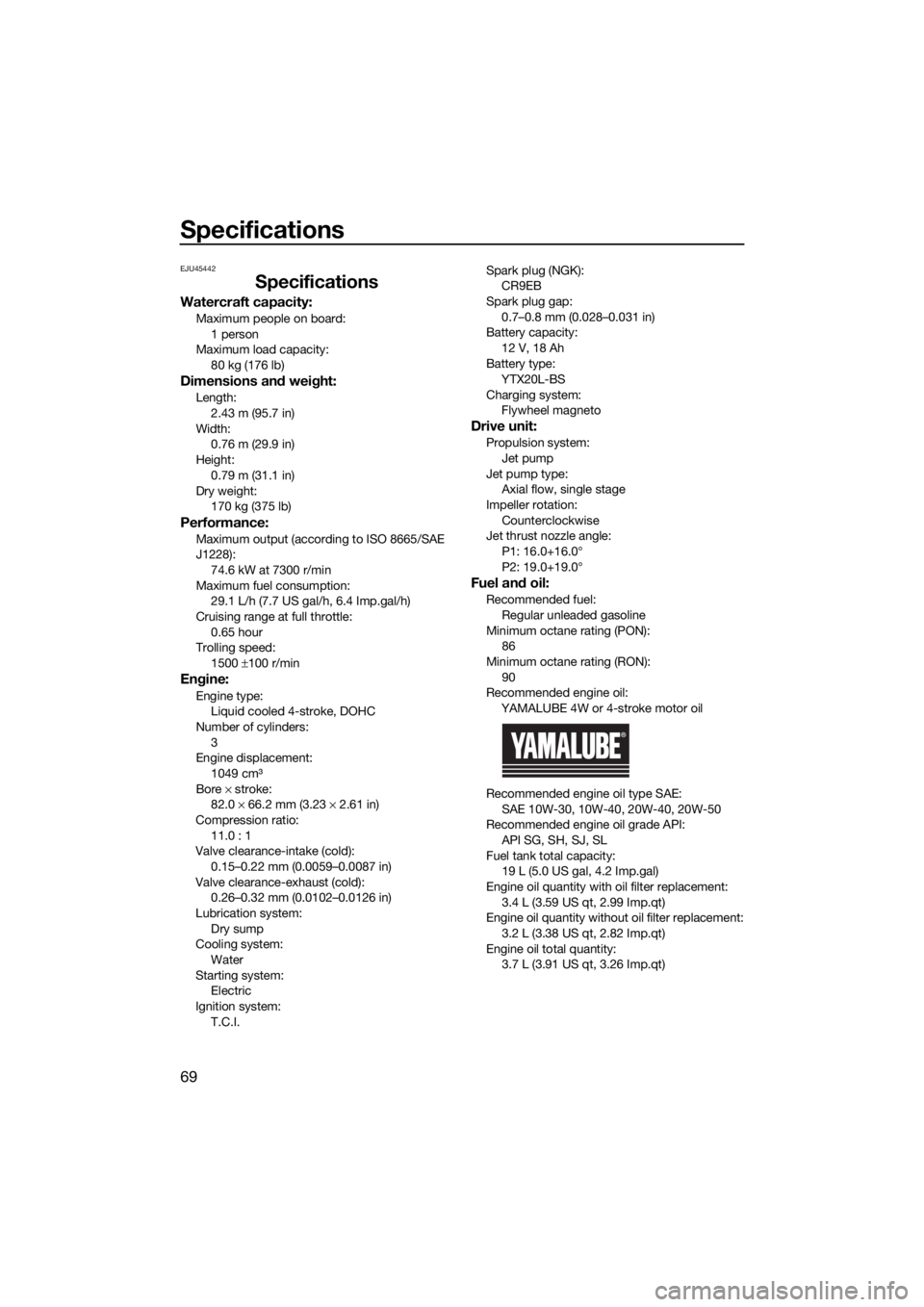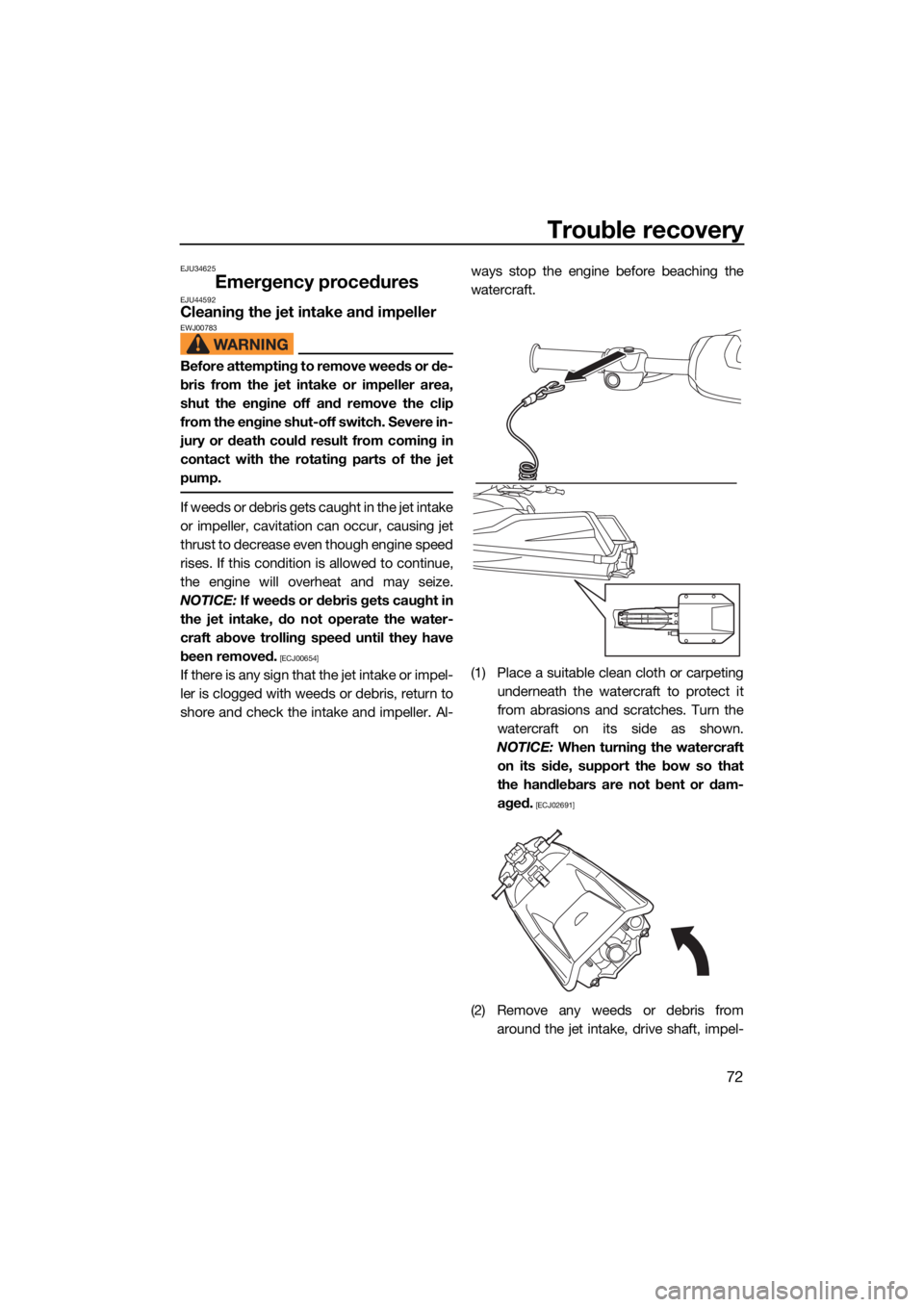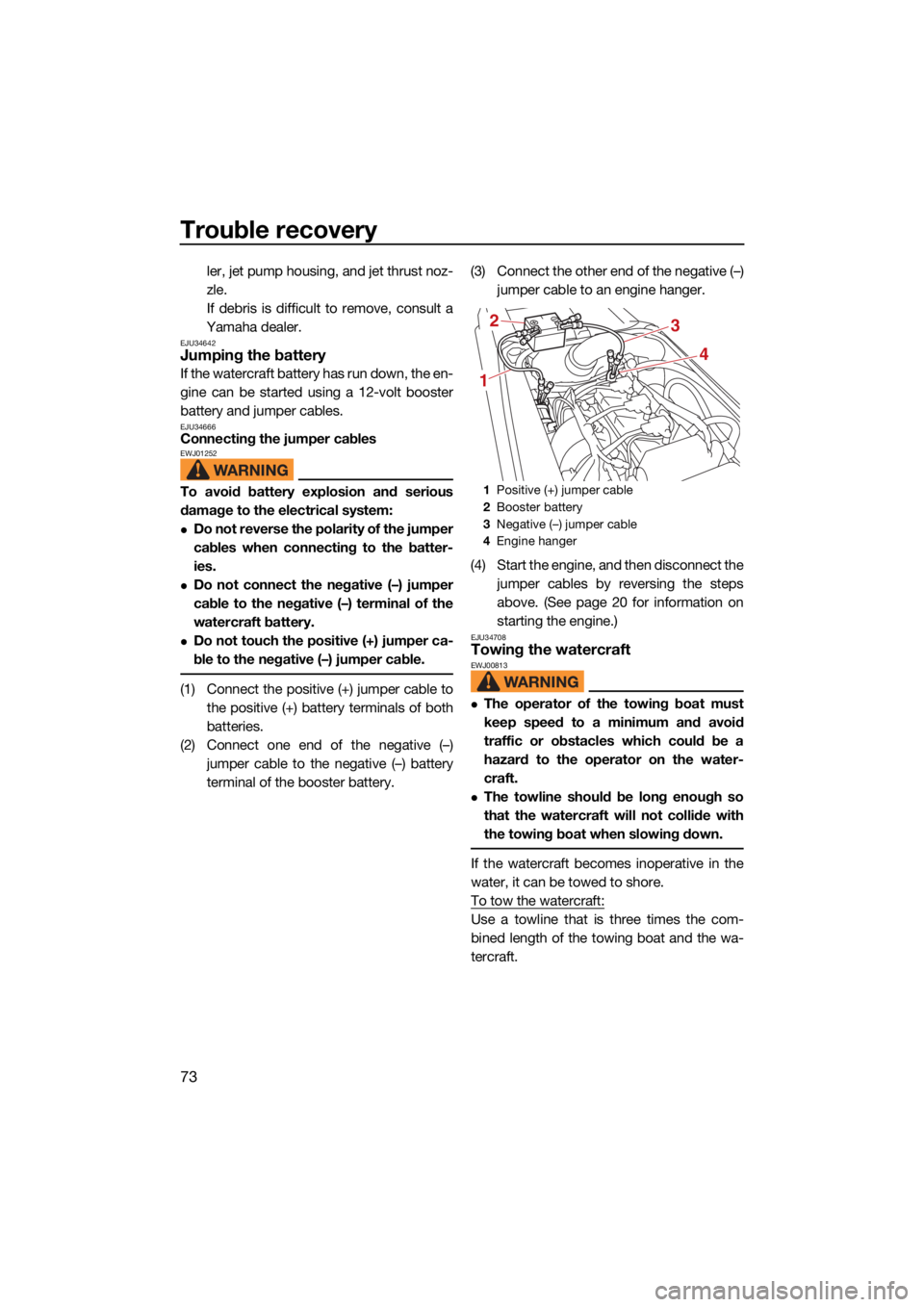engine YAMAHA SUPERJET 2022 Workshop Manual
[x] Cancel search | Manufacturer: YAMAHA, Model Year: 2022, Model line: SUPERJET, Model: YAMAHA SUPERJET 2022Pages: 84, PDF Size: 3.76 MB
Page 76 of 84

Specifications
69
EJU45442
Specifications
Watercraft capacity:
Maximum people on board:1 person
Maximum load capacity: 80 kg (176 lb)
Dimensions and weight:
Length:
2.43 m (95.7 in)
Width: 0.76 m (29.9 in)
Height: 0.79 m (31.1 in)
Dry weight: 170 kg (375 lb)
Performance:
Maximum output (according to ISO 8665/SAE
J1228):
74.6 kW at 7300 r/min
Maximum fuel consumption: 29.1 L/h (7.7 US gal/h, 6.4 Imp.gal/h)
Cruising range at full throttle: 0.65 hour
Trolling speed:
1500 ±100 r/min
Engine:
Engine type:
Liquid cooled 4-stroke, DOHC
Number of cylinders:
3
Engine displacement: 1049 cm³
Bore × stroke:
82.0 × 66.2 mm (3.23 × 2.61 in)
Compression ratio:
11.0 : 1
Valve clearance-intake (cold): 0.15–0.22 mm (0.0059–0.0087 in)
Valve clearance-exhaust (cold): 0.26–0.32 mm (0.0102–0.0126 in)
Lubrication system:
Dry sump
Cooling system: Water
Starting system: Electric
Ignition system:
T.C.I. Spark plug (NGK):
CR9EB
Spark plug gap: 0.7–0.8 mm (0.028–0.031 in)
Battery capacity:
12 V, 18 Ah
Battery type: YTX20L-BS
Charging system: Flywheel magneto
Drive unit:
Propulsion system:Jet pump
Jet pump type: Axial flow, single stage
Impeller rotation: Counterclockwise
Jet thrust nozzle angle:
P1: 16.0+16.0°
P2: 19.0+19.0°
Fuel and oil:
Recommended fuel:Regular unleaded gasoline
Minimum octane rating (PON): 86
Minimum octane rating (RON):
90
Recommended engine oil: YAMALUBE 4W or 4-stroke motor oil
Recommended engine oil type SAE: SAE 10W-30, 10W-40, 20W-40, 20W-50
Recommended engine oil grade API:
API SG, SH, SJ, SL
Fuel tank total capacity: 19 L (5.0 US gal, 4.2 Imp.gal)
Engine oil quantity with oil filter replacement: 3.4 L (3.59 US qt, 2.99 Imp.qt)
Engine oil quantity without oil filter replacement:
3.2 L (3.38 US qt, 2.82 Imp.qt)
Engine oil total quantity: 3.7 L (3.91 US qt, 3.26 Imp.qt)
UF4R71E0.book Page 69 Monday, May 10, 2021 1:14 PM
Page 77 of 84

Trouble recovery
70
EJU34562
Troubleshooting
If you have any trouble with your watercraft, use the troubleshooting chart to check for the
possible cause.
If you cannot find the cause, consult a Yamaha dealer.
EJU3457ATroubleshooting chart
Confirm the possible cause and remedy, and then refer to the applicable page.
TROUBLEPOSSIBLE CAUSE REMEDYPAGE
Engine does not
start (Starter motor
does not turn over) Engine shut-
off switch
Clip not in place Install clip
20
Fuse Burned out Have serviced by
Yamaha dealer—
Battery Run down Recharge58
Poor terminal con-
nections Tighten as required
58
Terminal corroded Clean or replace 58
Starter motor Faulty Have serviced by
Yamaha dealer —
Engine does not
start (Starter motor
turns over) Throttle lever Squeezed
Release20
Faulty Have serviced by
Yamaha dealer —
Fuel Fuel tank empty Refill as soon as pos-
sible 31
Stale or contaminat-
ed Have serviced by
Yamaha dealer
—
Fuel tank Water or dirt present Have serviced by Yamaha dealer—
Spark plug Fouled or defective Have serviced by Yamaha dealer—
Fuel injec-
tion system Fuel pump faulty Have serviced by
Yamaha dealer —
UF4R71E0.book Page 70 Monday, May 10, 2021 1:14 PM
Page 78 of 84

Trouble recovery
71
Engine runs irregu-
larly or stallsFuel Fuel tank empty Refill as soon as pos-
sible31
Stale or contaminat-
ed Have serviced by
Yamaha dealer
—
Fuel tank Water or dirt present Have serviced by Yamaha dealer—
Spark plug Fouled or defective Have serviced by Yamaha dealer—
Incorrect heat range Have serviced by Yamaha dealer —
Gap incorrect Have serviced by Yamaha dealer —
Electrical wir-
ing Loose connection Have serviced by
Yamaha dealer —
Fuel injec-
tion system Faulty or clogged in-
jectors Have serviced by
Yamaha dealer
—
Warning light or in-
dicator blinks or
comes on Fuel level
warning
Fuel tank empty Refill as soon as pos-
sible 31
Oil pressure
warning Oil pressure dropped Have serviced by
Yamaha dealer 24
Engine over-
heat warning Jet intake clogged Clean
72
Check en-
gine warning Faulty sensors Have serviced by
Yamaha dealer 25
Watercraft slow or
loses power Cavitation Jet intake clogged Clean 72
Impeller damaged or
worn Have serviced by
Yamaha dealer
72
Engine over-
heat warning Engine speed reduc-
tion control activated Clean jet intake and
cool engine
25
Oil pressure
warning Engine speed reduc-
tion control activated Add oil
24
Spark plug Fouled or defective Have serviced by Yamaha dealer—
Incorrect heat range Have serviced by Yamaha dealer —
Gap incorrect Have serviced by Yamaha dealer —
Electrical wir-
ing Loose connection Have serviced by
Yamaha dealer —
Fuel Stale or contaminat- ed Have serviced by
Yamaha dealer
—
Throttle lever Faulty Have serviced by Yamaha dealer—
L-MODE L-MODE is activat- ing. Deactivate the L-
MODE.
23
T
R
OUBLE
POSSIBLE CAUSE REMEDYPAGE
UF4R71E0.book Page 71 Monday, May 10, 2021 1:14 PM
Page 79 of 84

Trouble recovery
72
EJU34625
Emergency proceduresEJU44592Cleaning the jet intake and impellerEWJ00783
Before attempting to remove weeds or de-
bris from the jet intake or impeller area,
shut the engine off and remove the clip
from the engine shut-off switch. Severe in-
jury or death could result from coming in
contact with the rotating parts of the jet
pump.
If weeds or debris gets caught in the jet intake
or impeller, cavitation can occur, causing jet
thrust to decrease even though engine speed
rises. If this condition is allowed to continue,
the engine will overheat and may seize.
NOTICE: If weeds or debris gets caught in
the jet intake, do not operate the water-
craft above trolling speed until they have
been removed.
[ECJ00654]
If there is any sign that the jet intake or impel-
ler is clogged with weeds or debris, return to
shore and check the intake and impeller. Al- ways stop the engine before beaching the
watercraft.
(1) Place a suitable clean cloth or carpeting
underneath the watercraft to protect it
from abrasions and scratches. Turn the
watercraft on its side as shown.
NOTICE: When turning the watercraft
on its side, support the bow so that
the handlebars are not bent or dam-
aged.
[ECJ02691]
(2) Remove any weeds or debris from around the jet intake, drive shaft, impel-
UF4R71E0.book Page 72 Monday, May 10, 2021 1:14 PM
Page 80 of 84

Trouble recovery
73
ler, jet pump housing, and jet thrust noz-
zle.
If debris is difficult to remove, consult a
Yamaha dealer.
EJU34642Jumping the battery
If the watercraft battery has run down, the en-
gine can be started using a 12-volt booster
battery and jumper cables.
EJU34666Connecting the jumper cablesEWJ01252
To avoid battery explosion and serious
damage to the electrical system:
Do not reverse the polarity of the jumper
cables when connecting to the batter-
ies.
Do not connect the negative (–) jumper
cable to the negative (–) terminal of the
watercraft battery.
Do not touch the positive (+) jumper ca-
ble to the negative (–) jumper cable.
(1) Connect the positive (+) jumper cable to the positive (+) battery terminals of both
batteries.
(2) Connect one end of the negative (–) jumper cable to the negative (–) battery
terminal of the booster battery. (3) Connect the other end of the negative (–)
jumper cable to an engine hanger.
(4) Start the engine, and then disconnect the jumper cables by reversing the steps
above. (See page 20 for information on
starting the engine.)
EJU34708Towing the watercraftEWJ00813
The operator of the towing boat must
keep speed to a minimum and avoid
traffic or obstacles which could be a
hazard to the operator on the water-
craft.
The towline should be long enough so
that the watercraft will not collide with
the towing boat when slowing down.
If the watercraft becomes inoperative in the
water, it can be towed to shore.
To tow the watercraft:
Use a towline that is three times the com-
bined length of the towing boat and the wa-
tercraft.
1Positive (+) jumper cable
2 Booster battery
3 Negative (–) jumper cable
4 Engine hanger
1
23
4
UF4R71E0.book Page 73 Monday, May 10, 2021 1:14 PM
Page 81 of 84

Trouble recovery
74
(1) Securely attach the towline to the boweye of the watercraft being towed.
(2) Ride the watercraft with your body weight supported on the riding tray. Hold
on to the handlebars in order to balance
the watercraft and keep the bow up out
of the water. NOTICE: The bow must be
kept up out of the water during tow-
ing, otherwise water could flood the
engine compartment or water could
flow back into the engine, causing se-
vere engine damage.
[ECJ01331]
Tow the watercraft at 8 km/h (5 mph) or less.
NOTICE: Tow the watercraft at 8 km/h (5
mph) or less, otherwise water could flood
the engine compartment or water could
flow back into the engine, causing severe
engine damage.
[ECJ01322]
EJU34737
Submerged watercraft
If the watercraft is submerged or flooded with
water, drain the bilge water from the engine
compartment. Then, have a Yamaha dealer
service the watercraft as soon as possible.
(1) Remove the watercraft from the water.
(2) Drain the bilge water from the engine compartment. (See page 35 for informa-
tion on draining the bilge water on land.)
(3) Have the watercraft serviced by a Yamaha dealer as soon as possible.
NOTICE: Be sure to have a Yamaha dealer inspect the watercraft. Other-
wise, serious engine damage could
result.
[ECJ00792]
1
Bow eye
1
UF4R71E0.book Page 74 Monday, May 10, 2021 1:14 PM
Page 82 of 84

75
Index
A
After removing the watercraft from the water ..................................................... 56
B
Battery care.............................................. 58
Battery checks ......................................... 42
Battery, jumping....................................... 73
Beaching the watercraft ........................... 55
Bilge water check..................................... 42
Bilge water, draining ................................ 35
Bilge water, draining on land ................... 35
Bilge water, draining on water ................. 35
Boarding and starting in deep water........ 54
Boarding and starting in shallow water.... 53
Bow eye ................................................... 28
C
Capsized watercraft ................................. 54
Check engine warning ............................. 25
Cleaning ................................................... 60
Cleaning the watercraft ............................ 58
Communication disconnecting warning ................................................. 25
Cooling water pilot outlet ......................... 22
Cooling water pilot outlet check .............. 46
Craft Identification Number (CIN)............... 1
Cruising limitations..................................... 9
E
Emergency procedures ............................ 72
Engine break-in ........................................ 38
Engine compartment check ..................... 41
Engine oil ................................................. 33
Engine oil and oil filter .............................. 68
Engine oil level check............................... 42
Engine oil requirements ........................... 33
Engine overheat warning ......................... 25
Engine serial number ................................. 1
Engine shut-off cord (lanyard) check ....... 44
Engine shut-off switch ............................. 20
Engine stop/“L-MODE” switch ................ 20
Engine unit check..................................... 41
Enjoy your watercraft responsibly............ 15
Equipment ................................................ 26
F
Fire extinguisher check ............................ 45
Fire extinguisher holder............................ 29 Fire extinguisher holder, cover, and
band checks ......................................... 45
Flushing the cooling water passages....... 57
Fuel .......................................................... 31
Fuel level check........................................ 41
Fuel level meter ........................................ 24
Fuel level warning..................................... 24
Fuel requirements .................................... 31
Fuel system checks ................................. 41
G
Getting to know your watercraft .............. 47
Glossary, watercraft ................................. 16
H
Handlebar position, adjusting .................. 65
Hazard information................................... 13
Hood ........................................................ 26
Hood check .............................................. 46
Hull and deck check ................................ 45
I
Identification numbers ............................... 1
Indicator lights.......................................... 24
J
Jet intake and impeller, cleaning.............. 72
Jet intake checks ..................................... 45
Jet thrust nozzle angle, adjusting ............ 64
Jumper cables, connecting ...................... 73
L
Labels, important ....................................... 3
Labels, other .............................................. 7
Labels, warning .......................................... 4
Launching the watercraft ......................... 48
Learning to operate your watercraft......... 47
Leaving the watercraft.............................. 49
Limitations on who may operate the watercraft ................................................ 8
L-MODE ................................................... 23
Long-term storage ................................... 60
Lubrication ............................................... 60
M
Main components, location of ................. 17
Maintenance............................................. 63
Manufactured date label ............................ 2
Meter ........................................................ 24
Meter check ............................................. 46
UF4R71E0.book Page 75 Monday, May 10, 2021 1:14 PM
Page 83 of 84

Index
76
O
Oil pressure warning ................................ 24
Operating in weeded areas ...................... 55
Operating positions.................................. 47
Operating the watercraft .......................... 49
Operating your watercraft ........................ 47
Operation requirements ........................... 10
P
Periodic maintenance chart ..................... 66
Post-launch checks ................................. 46
Post-operation care ................................. 57
Pre-launch checks ................................... 41
Pre-operation check points ..................... 41
Pre-operation checklist ............................ 39
Primary Identification (PRI-ID) number ...... 1
R
Reboarding holder ................................... 28
Recommended equipment ...................... 12
Rustproofing ............................................ 61
S
Safe boating rules .................................... 14
Safety equipment check .......................... 45
Start switch .............................................. 20
Starting off ............................................... 52
Starting the engine on water .................... 48
Steering friction, adjusting ....................... 63
Steering pole ............................................ 22
Steering pole check ................................. 43
Steering system ....................................... 21
Steering system checks ........................... 42
Stern drain plug checks ........................... 45
Stern eyes ................................................ 28
Stopping the engine ................................. 49
Stopping the watercraft ........................... 51
Storage pouch ......................................... 28
Storage pouch checks ............................. 44
Submerged watercraft ............................. 74
Switch checks .......................................... 44
T
Throttle lever ............................................ 21
Throttle lever checks ................................ 43
Towing the watercraft .............................. 73
Transporting on a trailer ........................... 36
Troubleshooting ....................................... 70
Troubleshooting chart .............................. 70Turning the watercraft .............................. 50
W
Water separator ....................................... 22
Water separator check ............................. 41
Watercraft characteristics ........................ 13
Watercraft control functions..................... 20
Watercraft operation modes .................... 23
UF4R71E0.book Page 76 Monday, May 10, 2021 1:14 PM